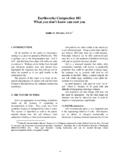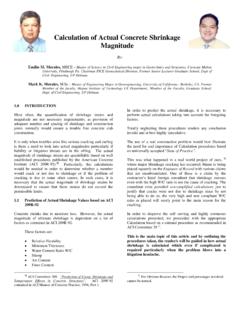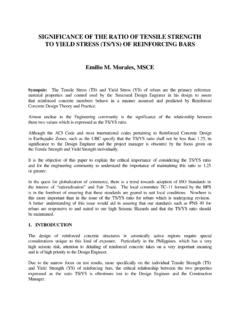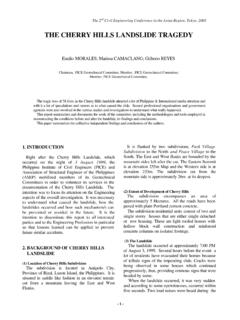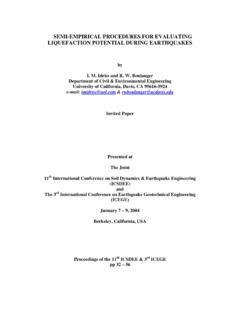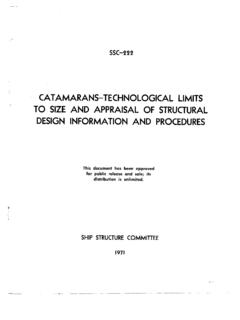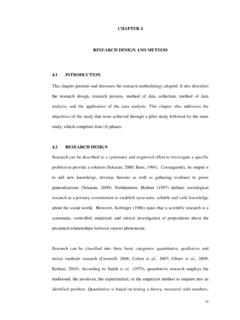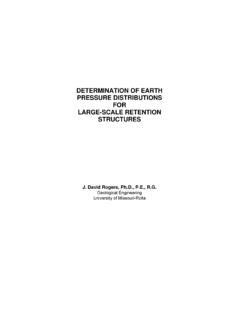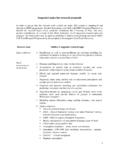Transcription of State of Practice in Soil Liquefaction Mitigation and ...
1 State of Practice in Soil Liquefaction Mitigation and engineering countermeasures Emilio M. Morales, MSCE1]. Mark K. Morales, ]. Summary The threat of Soil Liquefaction is all too real and the damage wrought to Dagupan City and other areas due to Liquefaction during the 1990 Luzon Earthquake indicate the need to provide engineered responses to mitigate or eliminate the threat. With the anticipated build up in private infrastructure and development, the availability of cheap land is becoming scarcer and scarcer and therefore, focus is being directed into the development of marginal lands which invariably would involve some risks due to potential for Liquefaction and other geotechnical concerns.
2 Particularly in the Philippines which is in a very active Seismic Zone, with very long coastlines with marine sedimentary deposits and inland alluvial valley deposits, potentially liquefiable loose to very loose granular soil deposits are prevalent. This paper discusses the phenomenon of soil Liquefaction , the causative mechanisms and the State of the Art approaches to determining Liquefaction susceptibility of a specific soil deposit and the factor of safety. This is followed by current State of Practice discussion addressing anti- Liquefaction counter measures and Mitigation methodologies available to engineers and developers.
3 1]. MSCE major in Geotechnics and Structures, Carnegie Mellon University, Pittsburgh, PA., Chairman, PICE Geotechnical Specialty Division., Principal, EM2A Partners & Co. 2]. Master of Science major in Earthquake Geotechnical engineering , University of California Berkeley, CA. Managing Director , Philippine GEOANALYTICS Inc. contact : Page 1 of 29. INTRODUCTION. General Soil Liquefaction is a sudden loss in strength in loose to very loose saturated granular soils due to ground shaking followed by a rapid increase in pore pressure.
4 The ground shaking, which is normally due to earthquakes or significant horizontal shearing and excitation of the loose to very loose soils, momentarily causes dislodgement of the precarious grain to grain contact of the individual soil grains. A different phenomenon on soft to very soft cohesive soils, which has been wrongly attributed as soil Liquefaction in the past, is another mechanism caused by repeated cyclic shearing of the soils. Particularly in very sensitive soils, the cyclic disturbance causes a significant loss in shear strength which could result in instability or bearing capacity failures.
5 This second phenomenon is not addressed in this paper as it is a totally different failure mechanism with the same causative or triggering events. Rapid increases in porewater pressure normally accompany this ground shaking. Due to the dislodgement, the superimposed weight on the ground is momentarily transferred to the porewater because the soil loses its strength due to loss of grain to grain contact. This momentary transfer further increases the porewater pressure in the saturated zone further buoying up the already dislodged soil grains.
6 Buoyancy causes the total collapse of the soil structure resulting in a liquefied mass which does not possess any shear strength or load carrying capacity. Thus, the loads (structures) imposed on the soil before the Liquefaction which originally was deemed stable momentarily loses the soil support leading to partial collapse or tilting to total collapse. The following effects of Liquefaction can occur in a vulnerable site when Liquefaction is induced by significant ground shaking: Lateral Spreading from Liquefaction . Lateral deformation induced by earthquakes is discussed below.
7 Page 2 of 29. Lateral Deformation. The occurrence of Liquefaction and its associated loss of soil strength can cause large horizontal deformations. These deformations may cause failure of buildings, sever pipelines, buckle bridges, and topple retaining walls. Three types of ground failure are possible. Flow failures may occur on steep slopes. Lateral spread may occur on gentle slopes. Figure Examples of Lateral spreading due to Liquefaction . 3]. Page 3 of 29. The third type of failure involves ground oscillation on flat ground with Liquefaction at depth decoupling surface layers.
8 This decoupling allows rather large transient ground oscillation or ground ]. In the past, as in the present, empirical and semi-empirical methods have been used in order to assess the Liquefaction susceptibility of a site. This ranged from the use of comparison charts of characteristic grain size envelopes of sites worldwide that have liquefied in the past (see Figure ) on which the characteristic grain size of a specific site is superimposed, the use of rule of thumb checks, to the development of the Cyclic Resistance ratio (CRR).
9 Even in the latter procedure, which is now universally accepted, recent developments in the understanding of Liquefaction has resulted in significant changes in our understanding of this phenomenon in soils, its assessment as well as the feasible countermeasures to mitigate or reduce the effects on civil engineering structures. It is the purpose of this paper to look into possible Liquefaction Mitigation technologies and discuss their effectiveness. BACKGROUND ON Liquefaction . Liquefaction is sudden loss of soil strength due to flotation of the individual soil grains from excess pore pressure and ground shaking during an earthquake.
10 However, before Liquefaction can occur the following conditions need to be satisfied which 4]. according to Seed are: Soil-type - Soils with 50% or more of their grain size in the range of to are potentially liquefiable when saturated. Intensity of Ground Pressure - To initiate Liquefaction local ground acceleration greater than is required. 3]. US DOD NAVFAC DM Soil Dynamics and Special Design Aspects . 4]. Seed & Idriss: Simplified Procedure for Evaluating Soil Liquefaction Potential" Journal of ASCE SM9. September 1971.
